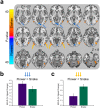The effect of threat on novelty evoked amygdala responses
- PMID: 23658813
- PMCID: PMC3643910
- DOI: 10.1371/journal.pone.0063220
The effect of threat on novelty evoked amygdala responses
Abstract
A number of recent papers have suggested that the amygdala plays a role in the brain's novelty detection circuit. In a recent study, we showed that this role may be specific to certain classes of biologically-relevant stimuli, such as human faces. The purpose of the present experiment was to determine whether other biologically-relevant stimuli also evoke novelty specific amygdala responses. To test this idea, we presented novel and repeated images of snakes and flowers while measuring BOLD. Surprisingly, we found that novel images of snakes and flowers evoke more amygdala activity than repeated images of snakes and flowers. Our results further confirm the robustness of the novelty evoked amygdala responses, even when compared with effects more traditionally associated with the amygdala. In addition, our results suggest that threatening stimuli may prime the amygdala to respond to other types of stimuli as well.
Conflict of interest statement
Figures





References
-
- Daselaar SM, Fleck MS, Cabeza R (2006) Triple dissociation in the medial temporal lobes: recollection, familiarity, and novelty. J Neurophysiol 96: 1902–1911. - PubMed
-
- Tulving E, Markowitsch HJ, Craik FE, Habib R, Houle S (1996) Novelty and familiarity activations in PET studies of memory encoding and retrieval. Cerebral Cortex 6: 71–79. - PubMed
Publication types
MeSH terms
Grants and funding
LinkOut - more resources
Full Text Sources
Other Literature Sources

